Ouistreham, Atlantic Wall Museum
Merville, the Battery
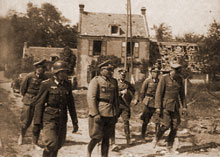
Generaloberst Dollmann (centre) inspects the Merville Battery on the 25th May 1944. On the far right is Oberleutnant Raimund Steiner, the commander of the Battery. At the time that the 9th Battalion attacked, Steiner was at an observation post on the beach.
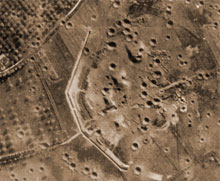
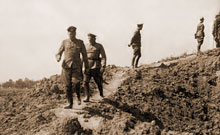
General Marcks inspecting bomb damage inflicted on the Merville Battery, on the 23rd May 1944.
German Battery
According to Allied intelligence, this battery contained four casemated 6” guns sighted so that they could fire on ships standing off Sword Beach. Neptune planners were obviously worried about the damage these guns might inflict the invasion fleet. The task of neutralizing the Merville Battery was given to the seven-hundred-man 9th Battalion, 6th Airborne Division, commanded by Lieutenant Colonel Terence Otway.
The plan Otway and his men had been rehearsing for months was daring. Otway's main force would parachute in some distance from the battery, gather their special equipments including flamethrowers, Bangalore torpedoes, and anti-tank guns then assemble just outside the battery's defences.

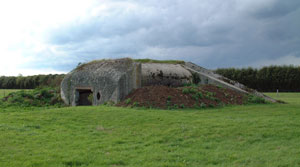
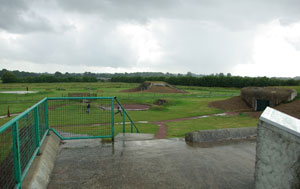
This force, divided into eleven teams, would lay the Bangalores under the perimeter wire, clear and mark the minefields, then take up covering positions to watch for the arrival of two tow planes with their gliders. On seeing Otway's signal (a star shell fired from a mortar), the glider pilots were to land inside the battery's perimeter. The garrison of some two hundred men would then be overrun by this combined assault from air and ground. Otway was to signal the fall of the battery with a flare before 0530, or ships of the bombardment force would take it under fire.
This carefully rehearsed plan began to unravel before the first paratrooper touched ground. Instead of dropping in their assigned drop zone, Otway's men were scattered over a few miles corridor. Some sticks took days to rejoin their outfit; of others no trace was ever found. Otway could assemble only 150 of his men by the time the attack was to begin. Most of the special equipment carried in by two of the battalion's gliders was likewise lost, including the mortar signal rounds.
The frustrated men on the ground could only look skyward as the two assault gliders swooped low across the battery, and then, receiving no signal, landed outside the battery's perimeter. Otway gave no sign of the dismay he must have felt at that moment, for no sooner had the gliders come down and while the defenders' attention was still on the skies, he ordered the wire blown and his assault teams to attack through the gaps.
The fight was over in ten minutes. Although half of the British force was dead or wounded, the Merville Battery had been silenced. Ironically, the much feared 150-mm canons turned out to be less formidable 75-mm guns.
The Comité du Débarquement has placed an excellent information sign at the entrance to the battery.
Casemate Number 1 now houses a great museum.